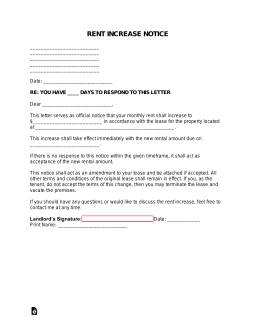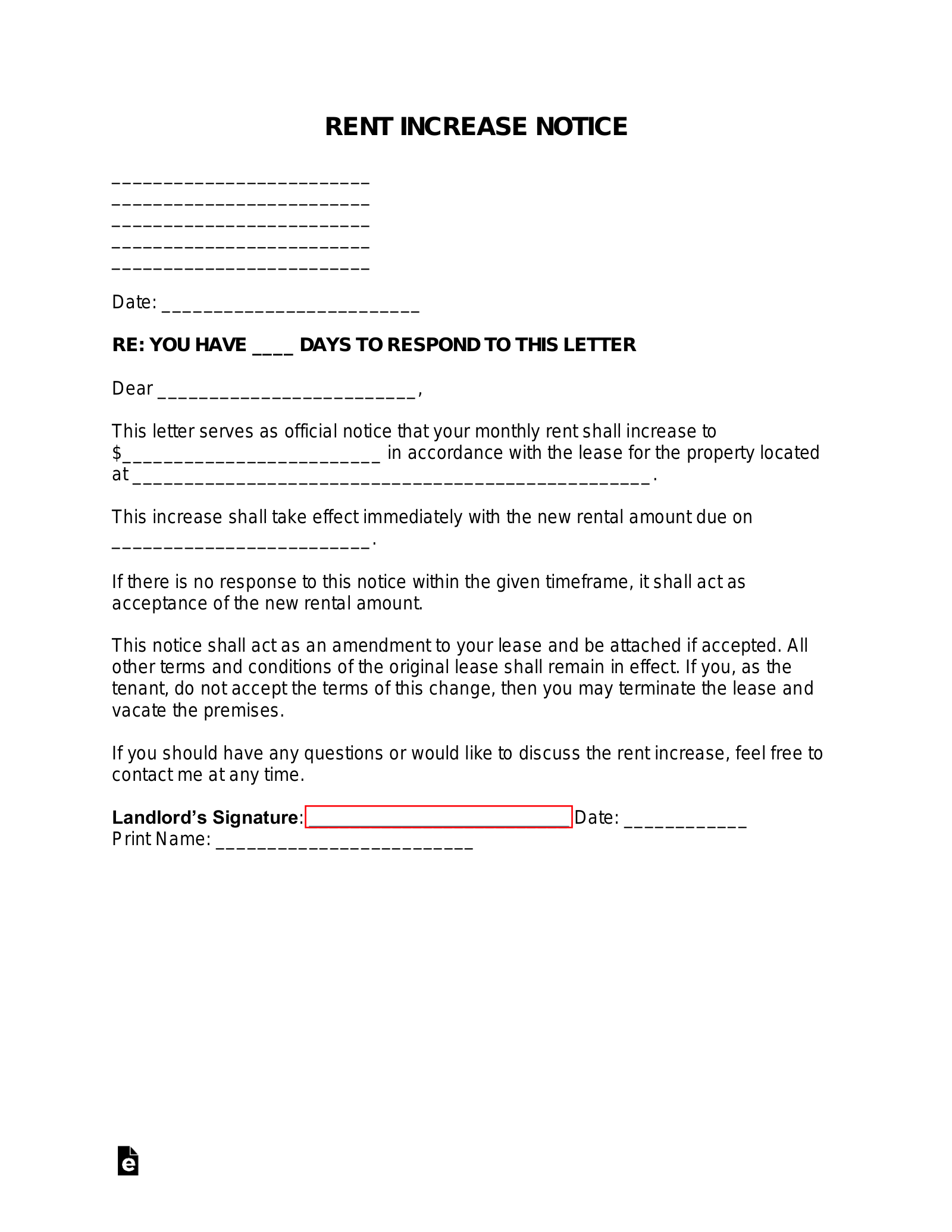Updated March 14, 2024
A rent increase notice is a letter written by a landlord that informs a tenant of a rent increase. The letter is commonly used to raise the rent for a lease about to expire or to amend a month-to-month rental agreement.
After the tenant receives the notice, they will have the option to either accept or reject the notice.
Sending Notice
A certified letter (USPS) constitutes legal notice. After being sent, the landlord will receive a receipt detailing when the tenant received the notice.
Table of Contents |
How to Legally Increase Rent (4 steps)
- Choose the New Rent Amount ($)
- Verify the Lease Terms
- Check the Required Notice Period
- Write and Send the Form
1. Choose the New Rent Amount ($)

Find comparable rent amounts in your area:
- Rentometer.com – Simply enter the address and the number (#) of bedrooms and be shown the average monthly rent along with real-time asking rents in the area.
- Zillow.com – Enter your address and be shown current properties for rent on a map.
- Craigslist – Select your area > Apts / housing > and enter your mailing address to be shown pictures and maps of the properties with current monthly rent amounts.
3. Check the Required Notice Period

Use the table below to determine the notice period in the State where the property is located (30 days is most common).
| State | Required Notice Period | Statute |
| Alabama | – | N/A |
| Alaska | 30 days | PUB-30 Page 17 |
| Arizona | – | N/A |
| Arkansas | – | N/A |
| California | 30 days if the rent increase is 10% or less and 90 days if more than 10%. | CIV § 827 |
| Colorado | – | N/A |
| Connecticut | – | N/A |
| Delaware | 60 days | § 5107 |
| Florida | – | N/A |
| Georgia | – | N/A |
| Hawaii | 45 days | § 521-21 |
| Idaho | 15 days | § 55-307 |
| Illinois | – | N/A |
| Indiana | 30 days | IC 32-31-5-4 |
| Iowa | 30 days | § 562A.13 |
| Kansas | As mentioned in the lease | § 58-2545 |
| Kentucky | – | N/A |
| Louisiana | – | N/A |
| Maine | 45 days for less than 10% increase; 75 days for 10% increase or more | § 6015 |
| Maryland | 90 days for year lease; 60 days for month-to-month | § 8-209 |
| Massachusetts | 30 days | The Attorney General’s Guide to Landlord and Tenant Rights |
| Michigan | – | N/A |
| Minnesota | Rental Period + 1 day | Landlords and Tenants Rights and Responsibilities |
| Mississippi | – | N/A |
| Missouri | – | N/A |
| Montana | 15 days | § 70-26-109 |
| Nebraska | As mentioned in the lease | § 76-1414 |
| Nevada | 45 days | NRS 118A.300 |
| New Hampshire | 30 days | RSA 540:2 |
| New Jersey | 30 days | Dept. of Community Affairs (Rent Increase Bulletin) |
| New Mexico | 30 days | § 47-8-15 |
| New York | – | N/A |
| North Carolina | – | N/A |
| North Dakota | 30 days | § 47-16-07 |
| Ohio | – | – |
| Oklahoma | – | – |
| Oregon | 30 days | § 90.220 |
| Pennsylvania | – | N/A |
| Rhode Island | 30 days | § 34-18-16.1 |
| South Carolina | – | N/A |
| South Dakota | 30 days | § 43-32-13 |
| Tennessee | – | N/A |
| Texas | – | N/A |
| Utah | – | N/A |
| Vermont | 60 days | § 4455 |
| Virginia | – | N/A |
| Washington | 60 days | RCW 59.18.140 |
| Washington D.C. | 30 days | Rent Control Fact Sheet |
| West Virginia | – | N/A |
| Wisconsin | 28 days | § 704.19 |
| Wyoming | – | N/A |
How Much Can a Landlord Raise Rent?
There is no federal law on how much a landlord can increase rent.
However, if the property is located in an area with rent control (such as some municipalities in California), the landlord will be subject to such limits.
Sample
[STREET ADDRESS]
[CITY, STATE, ZIP CODE]
[TELEPHONE]
[E-MAIL]Date: [DATE OF THIS NOTICE]
RE: YOU HAVE [#] DAYS TO RESPOND TO THIS LETTER
Dear [TENANT’S NAME],
This letter serves as official notice that your monthly rent shall increase to $[NEW RENT AMOUNT] in accordance with the lease for the property located at [PROPERTY ADDRESS].
This increase shall take effect immediately with the new rental amount due on [DATE WHEN NEW RENT STARTS].
If there is no response to this notice within the given timeframe, it shall act as acceptance of the new rental amount.
This notice shall act as an amendment to your lease and be attached if accepted. All other terms and conditions of the original lease shall remain in effect. If you, as the tenant, do not accept the terms of this change, then you may terminate the lease and vacate the premises.
If you should have any questions or would like to discuss the rent increase, feel free to contact me at any time.
Landlord’s Signature: _________________________ Date: ____________
Print Name: _________________________
CERTIFICATE OF SERVICE
I, [SENDER’S NAME], served the attached rent increase notice on [DATE OF SERVICE].
I served the rent increase notice by: (check one)
☐ – Delivering a copy to a tenant or occupant named on the rent increase notice. This person’s name is [RECIPIENT’S NAME].
☐ – Leaving a copy with a person who is at least 13 years old and is an occupant who is not named in the rent increase notice. This person’s name is [OCCUPANT’S NAME].
☐ – Sending a copy by certified/registered mail, with a return receipt from the addressee (USPS green card is attached).
☐ – Posting a copy on the property by: (check one)
☐ – Posting on the door.
☐ – Sliding underneath the door.
☐ – Other. [OTHER]
Sender’s Signature: _________________________ Date: ____________
Print Name: _________________________




